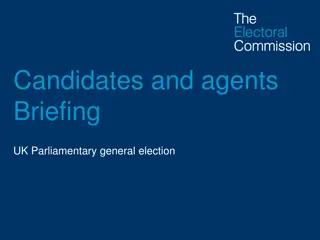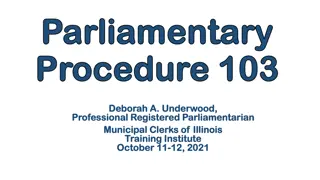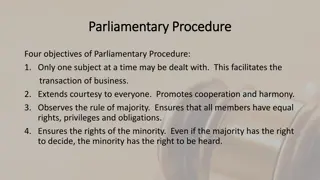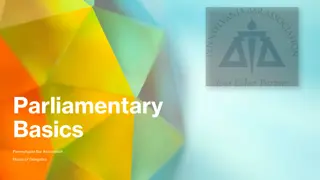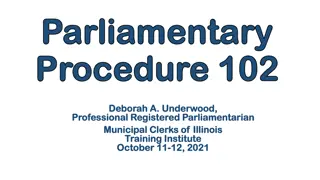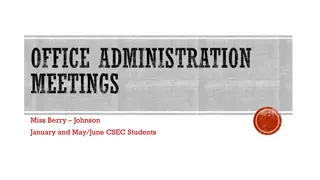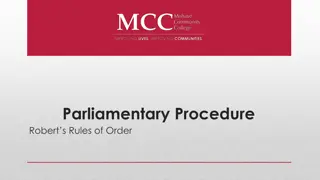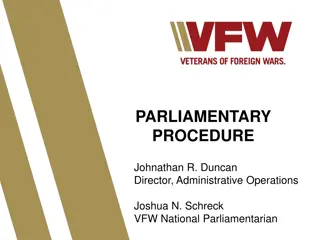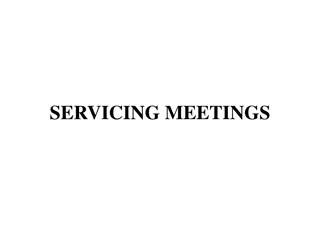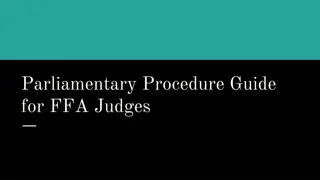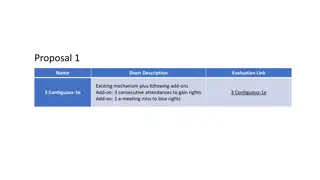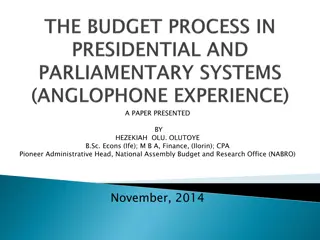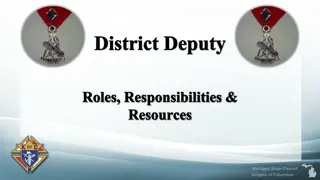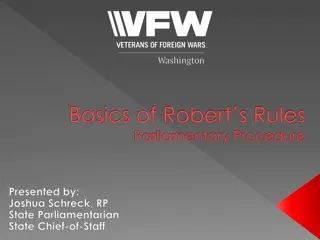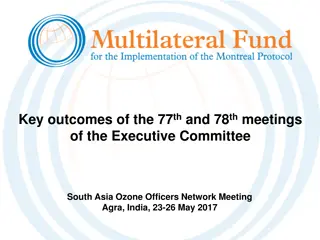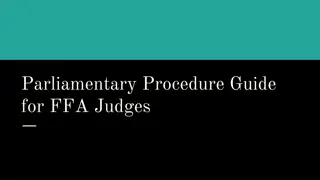Mastering Parliamentary Procedures: An Essential Guide for Effective Meetings
Understand the significance of parliamentary procedures in fostering equal rights, protecting minority opinions, and maintaining order in group settings. Learn the key principles, importance, and purposes of parliamentary procedures, along with practical tips for preparing and conducting meetings effectively.
Download Presentation

Please find below an Image/Link to download the presentation.
The content on the website is provided AS IS for your information and personal use only. It may not be sold, licensed, or shared on other websites without obtaining consent from the author.If you encounter any issues during the download, it is possible that the publisher has removed the file from their server.
You are allowed to download the files provided on this website for personal or commercial use, subject to the condition that they are used lawfully. All files are the property of their respective owners.
The content on the website is provided AS IS for your information and personal use only. It may not be sold, licensed, or shared on other websites without obtaining consent from the author.
E N D
Presentation Transcript
Getting Comfortable with Parliamentary Procedures
Parliamentary Procedures Finance & Business Development What is Parliamentary Procedure? Why is Parliamentary Procedure important? Using Parliamentary Procedure in meetings
What is Parliamentary Procedures? Parliamentary procedure, or parliamentary law, is the code of rules and ethics for working together in groups. Parliamentary law refers to the rules, laws, or regulations of organizations, governing the orderly, expeditious and efficient transaction of business and meetings.
Why is it important? All members have equal rights Minority rights must be protected Full and free discussion is an essential right Use simplest and most direct procedure
Why is it important? Only one question considered at a time Logical precedence governs order of discussion Members must be recognized before speaking All remarks are directed through the chair
Why is it important? No member may speak twice to the same question until all others have had an opportunity to speak Members may not question the character or motives of other members Members have a right at all times to know what question is before the assembly and what affirmative and negative votes mean
Purpose of Parliamentary Procedures Ensure majority rule Protect the rights of minority, the absentees, and individual members Provide order, fairness and decorum Facilitate the transaction of business and expedite meetings
Get Ready for the Meeting Develop the Agenda Send Meeting Notices (time, date, location, agenda) Post the Agenda Prepare Information for the meeting
Duties of the Chair Chair is responsible for the agenda Members may place items on the agenda Chair is responsible for administering the group s deliberations.
Basic Rules for the Chair Must have a quorum to conduct any business Members must be recognized by the Chair before speaking Except when appealed to the assembly, the Chair rules on all procedural issues Chair may not make motions not debate questions, except speaks first and last in an appeal Chair may vote only to make or break a tie vote
Effective Meeting Basics Publish Agenda before meeting Each item is assigned a time limit Start the meeting on time Follow the Agenda Changes to the Agenda require a vote End the meeting on time.
Typical Agenda Opening Remarks and Call to Order Roll Call and Establish Quorum Reading of the Minutes of the last meeting and approval of Minutes Officers Reports Treasurer s Report Committee Reports Old Business New Business Announcements Adjournment
Old Business Old or Unfinished Business: Business needed to be addressed or completed from a previous meeting Unfinished business is indicated in the Minutes
Introducing New Business - Motions There are three steps to bring a motion before the group: Step 1: A member makes a motion. Introduces the principal subject. Only one main motion may be considered at a time and must be disposed of before another can be considered. Step 2: Another member seconds the motion. Seconding a motion shows support by other members and puts the motion to a vote. Step 3: The chair states the question on the motion.
Motions Three Steps in Considering a Motion: Step 1: The members debate the motion (unless no member claims the floor for that purpose). Debate or discussion of the motion allows: Members to raise any concerns they may have about the motion Others to be persuaded to vote one way or another Additional information about the motion to be provided
Motions Debate or Discussion of a Motion 1. A member wishing to speak from the floor shall first secure recognition for the chair and address only the chair. 2. Speakers shall indicate their purpose in accordance with parliamentary procedures. For example, I speak in favor of the motion: or I speak in opposition to the motion. 3. There is an establish time limit that each member may speak. For example, the ACA Governing Council is allowed five minutes to speak at any one time, nor more than twice on the same question. Members may not speak a second time, unless everyone that wishes to speak is given the opportunity to speak for the first time. 4. In order to expedite business, the chair may limit equally the time or number of speakers for each side of a question, to the total time for debate, by a majority vote.
Motions When debating: Always address remarks to the chair, never using a member s name where it is possible to describe him/her otherwise. The mover of the motion may not speak against his or her own motion, although the mover may vote against it. If the mover changes his or her mind, he or she can request to withdraw the motion. Discourteous language is never used.
Motions When debating: The correction of a statement of facts may be denied, but do not question the motives of a member. The maker of the motion is always entitled to the floor first. Confine debate to the question under consideration. Do not waste time with frivolous arguments or repetitions.
Motions Amend the Motion 1.Allows for changes to be made to the motion. 2.No more than 2 amendments can be considered at one time. 3.Requires: 1. Second 2. It is debatable and amendable 3. Majority 4.Main motion can be altered by: 1. Addition adding a word or phrase 2. Subtracting (striking out) removal of part of the motion but not changing the intent. 3. Substitution removing part of the motion and inserting a new word or phrase.
Motions Step 2. The chair puts the question to a vote. A. The chair restates the question. B. The chair takes the vote.
Motions C. Methods of voting: Unanimous Consent no member objects to a proposal that meets with general approval; a vote of silent agreement. Voice Vote - most common for of voting. All in favor of the motion, say aye. Those opposed, say no. Rising Vote method used when a two-thirds vote is required.
Motions Show of Hands an alternative motion for a rising vote. Counted Vote can be ordered by the chair when it appears a voice vote is unclear and it can be ordered by a majority vote of the assembly. Ballot or Roll Call Vote can be ordered by a majority vote of the assembly.
Motions D. A member s failure to vote at a meeting through nonattendance or abstention implies his or her consent to the decision of those who do vote. However, members may at times be expected or required to abstain or recuse themselves from voting when there are extenuating circumstances, such as personal conflict of interest on the pending subject. Abstentions are generally ignored when the results of a vote is calculated.
Motions Step 3. The chair announces the results of a vote. A complete announcement should include: Report of the voting itself, stating which side prevailed. Declaration that the motion is adopted or lost. Statement indicating the effect of the vote or ordering its execution.
Classifications of Motions Main Motion: Introduces a principle subject Requires a second and are debatable A majority vote is required
Classifications of Motions Privileged Motions: Does not relate to a pending question, however they are of such great importance that they take precedence over all other motions. Privileged Motions include: Fix time to adjourn sets date and time to adjourn meeting (requires second, not debatable, amendable and majority vote) Adjourn ends current meeting immediately (requires second, not debatable, amendable to time only, and majority vote) Recess temporary beak in a meeting (requires second, not debatable, amendable to time only, and majority vote) Raise a Question of Privilege secures comfort for members (requires nothing the question is posed and decided upon by the chair) Call for the Orders of the Day demands compliance with the agenda or seek information on order of agenda (requires nothing addressed by the chair)
Classification of Motions Subsidiary Motions: Applies to other motions for the purpose of appropriate disposal Subsidiary motions include: Lay on the table delays a motion briefly until it is taken from the table (requires second, not debatable, not amendable, and majority vote) Call for the previous question ends debates immediately (requires second, not debatable, non-amendable, and 2/3 vote) Postpone definitely delays the motion to a certain time (require second, debatable, amendable, and majority vote) Refer to a committee assigns the motion to a committee (requires second, debatable, amendable, and majority vote) Amend changes motion by addition, subtraction, or substitution (requires second, debatable, amendable, and majority vote) Postpone indefinitely kills the motion without vote (requires second, debatable, not amendable, and majority vote)
Classification of Motions Incidental Motions: Correct ill-advised actions Correct improper use of parliamentary procedure Incidental motions include: Object to the consideration of question stops offensive or inappropriate measures (requires no second, not debatable, not amendable, and 2/3 vote) Appeal from the decision of the chair allows members to overrule the chair if they feel the chair made a decision not in agreement with the group (requires second, only debatable if motion was debatable, not amendable, and majority vote) Rise to a point of order parliamentary errors have been made (requires nothing decided on by the chair) Withdraw a motion motion proposed is retracted. Can only be made by the member who proposed the original motion (requires nothing chair asks for objections, if there is an objection, majority vote is needed) Suspend the rules make exceptions to the bylaws of the organization (require second, not debatable, not amendable, and 2/3 vote) Call for the division of the house requires a countable vote if voice vote was used (requires nothing addressed by the chair) Rise to parliamentary inquiry check on parliamentary questions or ask how to carry out an ability (requires nothing chair addresses the issue)
Classification of Motions Unclassified Motions: Having a definite purpose but are not classified as any other type of motion Usually pertain to action taken at a previous meeting Unclassified Motions include: Reconsider corrects and action taken in error. The member who moves to reconsider must have been on prevailing side of the motion (requires second, debatable, not amendable, and majority vote) Rescind revokes previous action (requires second, debatable, amendable, and 2/3 vote) Take from the table resume consideration of tabled motions (requires second, not debatable, not amendable, and majority vote)
Ranking Motions Privilege Motions 1. Adjourn 2. Recess 3. Question of privilege Subsidiary Motions 4. Lay on the table 5. Previous question (end debate) 6. Limit or extend debate 7. Postpone to a certain time (or postpone definitely) 8. Commit or refer (to committee) 9. Amend 10. Postpone indefinitely Main Motion
Parliamentary Procedures in Action To do this Introduce business (main motion) You say this I move that
Parliamentary Procedures in Action To do this You say this Amend a motion I move this motion be amended by
Parliamentary Procedures in Action To do this You say this Suspend further consideration of something I move we table the motion
Parliamentary Procedures in Action To do this take up a matter previously tabled You say this I move to take from the table
Parliamentary Procedures in Action To do this Postpone consideration of something You say this I move we postpone this matter until
Parliamentary Procedures in Action To do this Have something studied further You say this I move we refer this matter to committee
Parliamentary Procedures in Action To do this Request information You say this Point of information
Parliamentary Procedures in Action To do this Ask for actual count to verify voice vote You say this I call for a division of the house
Parliamentary Procedures in Action To do this End debate You say this I move the previous question
Parliamentary Procedures in Action To do this Reconsider something already disposed of You say this I move we reconsider our action relative to
Parliamentary Procedures in Action To do this Object to procedure or personal affront You say this Point of order
Parliamentary Procedures in Action To do this Vote on a ruling by the chair You say this I appeal the Chair s decision
Parliamentary Procedures in Action To do this Complain about noise, room temp, etc. You say this Point of privilege
Parliamentary Procedures in Action To do this Recess meeting You say this I move that we recess until
Parliamentary Procedures in Action To do this Adjourn the meeting You say this I move that we adjourn
Wrap Up Parliamentary Procedure is based on Two Democratic Principles: It recognizes Majority Rule It protects the Rights and Privileges of the Individual



